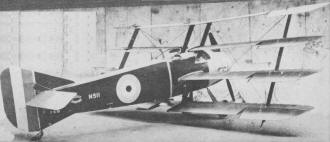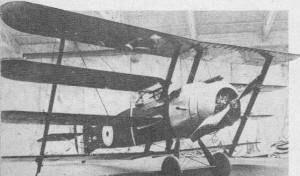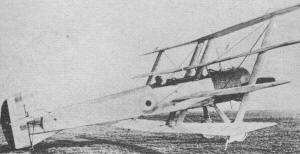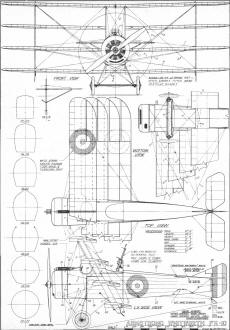|
If two and three wings was good
for the early aeroplanes, then surely four and more would be even better. That seemed
to be the prevailing thought in aircraft design - at least for a short time. In the case
of the F.K. 10, the primary reason for more wings was to be able to use a short
chord and thereby afford the pilot better visibility in dogfight scenarios. An all-flying
stabilizer (stabilator) was used for improved maneuverability. Obviously that
whole thing didn't work out. This quad-wing plane, aka "quadruplane," built by Armstrong-Whitworth
in 1916 was one of the few built in production. The author of this article that appeared
in the July/August 1963 edition of American Modeler is none other than Peter
Bowers, designer of the award-winning Fly Baby biplane. Hobby King now sells an
Armstrong-Whitworth F.K. 10 model.
Armstrong-Whitworth F.K. 10 Quadruplane
Plans by Jim Morrow Photos and Notes by Peter M. Bowers

First "Production" quad built by Armstrong Whitworth. This particular
airplane was originally powered with a 110-hp Le Rhone rotary, later changed to 130-hp
Clerget. Compare fuselage and tail with prototype.
Hoo boy, what a life. We now have a dilemma. Since we now reside in Buffalo, N.Y.,
can we still use "Wild Bill" as a pseudonym? This report is from a motel overlooking
the Flying Bisons, Inc. R/C field. Stepped from car to be greeted by the homey sound
of a 45 winding on. Hain't found any U/C people yet, but then with no models and no shop,
who cares? Drug along some letters and such, so this here column will be a bit of a hodge-podge.
Stopped by Top-Flite Models on the way up here so the kid's Atlas nose cones are now
flying about the room. Sid and Mike showed us thru their fine plant and we looked over
their new Flite Streak Trainer (15's to 29's). Due for imminent delivery, designed by
George Aldrich. These fellows go a long way to put out high quality merchandise. Called
Carl Goldberg but he was out flying. Talked to Paul Stawinago awhile. He told me the
Sky Knights with 25 active members were starting Goodyear Racing. Look around, sport
fans, these little ships are catching on. Carl has some new stuff on the board and in
test also scheduled for July and later delivery.
He Died A Violent Death. Headline from newspaper related to a 19
year old boy who not only sniffed glue but used a plastic freezer bag over his head to
concentrate the fumes. Of course the MODEL AIRPLANE glue was prominently mentioned. Not
that we don't have enough trouble with noise and short-sighted city fathers, people now
use our equipment to commit suicide. Of course, the newspaper could have called it "Household"
glue ... The point? Cement fumes are toxic, but the tubes are marked with warnings. So
who reads directions? Cements of acetate base and those containing Toluol, Toulene, Methyl-Ethyl-Ketone
or Butyl Acetate can damage the liver, lungs, frontal lobe of the brain and the bone
marrow where blood cells are formed. Sure it takes a lot of fumes, but it seems that
the effect is cumulative (adds up).
Solution - don't work in a closet or tightly sealed area. Keep room well ventilated,
meaning open windows and some movement of air. Use horse-sense. Keep in mind that automobiles,
toothbrushes, soft drinks, pencils and marshmallows are dangerous if used improperly.
We heard of an old Chinese gentleman who drowned in a cup of tea (had a fainting spell
and inhaled the tea while unconscious).
Point 2: Our chemicals are no more dangerous, per se, than dozens of household items,
so long as we use them sensibly. Meanwhile, send your local newspaper some good news
about model airplanes.
Ever pilot a combat model that could cut its own streamer? Walter Williamson's "Flying
Flounder" has turned two complete loops within its own streamer length! Bonnie Jones,
Virginia State winner in Miss Universe beauty contest, poses with Walt's newest, design.
Oops. Frantic note from John Kilsdonk about the Detroit Combat Invitational
Trophies. They are worth $50 Total, not each as reported here. Sorry, John. Cancel those
cattle boat reservations. Still a lot of sharp combat flying on July 7.
Pylon Fuel Bulb. Latest addition to an excellent line is this big
6-oz Pylon Brand fuel bulb with several innovations toward rapid fueling of T/R &.
R/R models. It uses a 3/16" O.D. tube with a hemi-spherical cavity nylon end which mates
with a ball end fitting to go on your tank fill tube. You can hit the tank from any angle
up to 30° and still get full flow. Included are a special wire to fix the rubber
bulb to the molded nylon cap for filling pressure tanks, a large I.D. rubber tube, and
two eyelets for preparing the ends of 3/16" O.D. tank fillers.
The bulb holds exactly 6-oz of fuel IF you hold the tube straight up after filling,
squeeze out remaining air and then suck in more fuel. On one plunge fills it pulls in
from 4 1/2 to 5-oz of fuel.
"Little Outlaw". Finished model by L. H. Hoff was given a 20 flight
wringing out in high wind and one or two in calm. It is an excellent handling job with
extremely tight cornering ability, due to correct control arms, thick (20%) wing and
26 ounce weight. Powered by a Stunt Fox 35 it is fast (around 65) on 10x6 prop. Even
when we richened her out to a slow blubbering run the Outlaw performed well. Had a real
ball in 20 to 35-mph wind after the engine quit. You can keep doing 8's and loops as
long as the breeze holds. Also noted extremely good tug under all conditions, even when
we moved the elevator to 45° and did some fully stalled maneuvers.

Relatively small size of the four wings is apparent in this view of
the first Phoenix quad. No horizontal stabilizer was used (full-flying stab, aka stabilator).
Hoff reported reasonably easy construction although he finally nailed the wing down
to dry. The fuselage can be hollowed further without loss of strength and the construction
gives you a fuselage-solid ship with profile-ease. Kits should be well into your shop
by now. Price $7.95.
FAI T/R Times Going Down. Two reliable sources report on a So. California
T/R with 4th place time of 4:56! The rest? 4:45, 4:47 and 4:53. Seems all of our active
U.S. teams are getting better. Some of the Huntsville gang are flying the event. Phil
Edwards pointed out a peculiar fact: In Europe relative performances for any set of teams
from a given country were very close to each other. Now we are doing it. Is communication,
practice or what the answer? Our equipment has not changed much in 3 years, but the performance
is better and better. Good shoe.
Roberts Throttles Still Available. Bob Smurthwaite is now in Bend,
Oregon, with North Pacific Products Co. He asks us to announce that Harold Leopold has
the J. Roberts equipment and know-how to install Vari-Speed slides in your engine. Prices
should be the same and workmanship equal. As a matter of interest, I've put over 200
hours on my first Vari-speed engine, a Fox 19, and am still using the original Ohlsson
Gold Seal Throttle plug! Scared to take it out, now.
Anyhoo, address Harold Leopold, Valley Hobby Center, 216 "C" Street S.E., Auburn,
Washington.
Out of our field a bit, but worthy of mention, North Pacific will soon introduce a
line of Beginners kits, a H/L glider, an all balsa ROG, and a rubber powered Bipe. Actually,
the beginner is getting some skilled attention lately and more coming.
Engine Size vs Lines. Nick Hutak, Monmouth, N.J., asks about what
size lines to use. Contest flyers must refer to the rule book since they are spelled
out loudly and clearly. However, sport types, here are some "safe" ... both strength
and performance ... sizes. Engine up to .051 cu. in. displacement use either commercially
packaged Dacron or nylon cord up to 30' long or .006-dia by 35' to 40' long. From .051
thru .099 use .008-dia by 45' to 55' long. From .099 thru .199 use either .010-dia by
60' or .012-dia by 52 1/2'. From .199 thru .45 use ..015-dia by 60' to 65' long. Over
.45 use .018-dia by 60' to 70'.
These are all standard make lines either stranded or solid, with stranded being easier
to maintain during average flying. These lines are neither too light nor too heavy for
the basic engine. We have found that line diameter and length are basically a function
of engine size. Also as a rule of thumb each increment of diameter (approximately .002)
is about equal in drag and yaw angle effect to 10 feet of length. For instance .012 by
52 1/2' lines perform equally with . 010 by 60' on the same ship. Questions anyone?
Nick also asked about tank size for length of run. This is quite variable, although
3 1/2 to 4-oz is adequate for 35 stunt ships.
Oh, yes, Sullivan Products makes a real good line storage reel for a buck. Ask your
hobby shop man for it.

First Phoenix-built quad, equipped as two-seat fighter. Notice use
of open-bottom cowling around 130-hp Clerget rotary.
New Items Potpourri. Bill's Miniature Engines will manufacture a
right-angle FAI Monoline handle. We saw a prototype of it when Tom Vincent and Bill Kim
dropped by Tulsa. Unit will be flex cable driven around the comer with a tensioned spiral
and ball thrust bearings throughout. Write Bill McGraw at 1325 Carol Dr., Memphis 16,
Tenn. Also note that World Engines now has an 8x8 prop which is stiff enough for hand
starting on R/R engines, but light enough for extra revs. Bill has these. Looked over
the prototype kits for the Kansas "Duster" A. An FAI speed ship or A, as you wish (just
change fuel). Wood shaping is excellent and complete. At the time, pans were still a
problem, but being ironed out. These ships will eventually be made for B&C. Also
at aforementioned address.
Received sample of Tatone's new Aluminum Speed Pans, a B size. Now here's a buy and
a half. Not only are all 9 holes tapped, blind yet, the screws provided, but the pan
is mirror polished outside. Front is finished for standard spinners with little or no
trimming. Inside needs no work, either. Frankly prices belie the quality. Address Tatone
Products, 1275 Geneva Ave., San Francisco 24, Calif. Prices: 1/2A-$3.50; A-$4.25; B-$4.50;
C-$4.95 and Proto-$4.95. Specify engine and displacement when ordering or order an undrilled
pan.
More Speed Pans Available. You may or may not know that Harter's
Royal Line is no longer made. However, several hundred speed pans including the die-cast
mag proto-R/R pan are still available from Schaefer's Hobby Shop, 5609 E. Virginia, St.
Louis 11, Mo. Art Schaefer says he has a good stock of each size. Priced to wit: 1/2A-$2.50;
A-$2.95; B-$3.50; C-$3.95; Proto & R/R-$3.95. Also some of the Harter Dural Proto
landing gear with nut and bolt set for 79 cents. Enclose 25c for handling and postage.
Walter
R. Williamson (6104 Alexander St., Norfolk, Va.) has a major problem. His fish-like "Flying
Flounder" can turn such small circles that in a combat contest he's apt to cut his own
streamer. So - who gets the points? and if he hits himself in the collision zone, who
loses? Walt doodled up the design while hospitalized, then built a 12H wingspan version
which flew for a year. Next came a "big" one - 15 inch span. Third model was 9" and that's
the one which raised the points question because of its tight turning ability. Current
design (left) has wingtip on outboard side only. To make ribs, cut 8 top halves, then
clue together. Brace in middle of rib goes on the outside of end ribs, on the inside
of center ribs.
Your Old Tree Surgeon Finally Fell Out Of A Patient. FAI Stunt Team
selection reported in CLC earlier got shot down and is officially superseded by an AMA
Executive Council approved program. By now, officially printed in MA, summary follows:
Finals held in Midwest Area (probably Chicago) in 1964 during Memorial Day weekend. To
get to finals you qualify by either of two methods. Win first in a AAA Stunt contest
with at least 5 contestants. Stipulatio - you pay special FAI Qualification fee - that
is, the Stunt at that meet must be declared an FAI Qualification contest.
OR - Place in top three at Semi-Finals of FAI Regional Contest. To get to these you
win 1, 2 or 3 in any sanctioned contest (Stunt of course) IF you pay FAI fees prior to
flying and submit proper forms.
Fees, 3, 2 and 1 buck O-S-J respectively. Three Semi-Final contests scheduled for
Labor Day Weekend 1963 on West Coast, Mid-West and East Coast. Top man in each Semi gets
travel money to U.S. Finals. Note: no one under 14 can compete in FAI events.
Regional Program Directors are: East - Jean G. Pailet, 2514 Seventh St., East Meadow,
N.Y. Central - Art Schaefer, 5609 E. Virginia, St. Louis 11, Mo. West - Pending. East
Region - District 1 thru 5; Central Region - District 6 thru 9; West Region - District
10 & 11.
In case you're confused, the program we published 4 months ago was the one submitted
to AMA by the Stunt Committee and was approved by most of the 20 flyers capable of FAI
per-formance. THIS final program is the OFFICIAL program approved by the AMA Executive
Council. Clear? Okay, so dry those tears.

Prototype Armstrong-Whitworth F.K. 10 with shallow fuselage and 110-hp
Clerget engine.
Saw Bob Gialdini. He revealed his trade secret on perfect Plastic
Balsa fillets. Build fillets in thin layers, since it shrinks on drying. Mold the wet
material with finger, but keep the finger well-moistened with thinner or thin dope. Allow
plenty of drying time per layer. Then, after sanding to shape, rub on many coats of C-77
cement. Boz sez every evening he slaps on one coat. Sure it takes time, but any solvent-evaporation
material must be thoroughly dried and applied in thin discreet coats.
We got a look at Bob's unpainted "Stinger". No mistake that this bird is an original.
Not really wild lines, but much great care to be different. He was still trying to develop
a color scheme to accentuate the flowing lines of the model.
Rools-Schmols. Precision Acrobatics has come under fire as being
boring, stagnant etc. and etc. Nuts!!! It's may be boring for some who don't participate
because everything goes smoothly and precisely or smash. Stagnant, never. Sure it's tough
to win, but. no possible change in pattern (short of ridiculous gyration) could knock
the top men out of their saddles. They are on top because they are good. And note this:
They weren't legislated up there! Any combination of maneuvers, within the capabilities
of present equipment could be learned in one week by any good flyer. Also, what other
event has so many NEW ships each year, without losing old standards? Where else do you
see such beautiful workmanship? So don't bother PA, you non-PA'ers. Work on the events
with obvious flaws.
Egg-Heads Abound. The line rake discussion drew some extremely well
thought-out, engineering analyses along the same line, toward the same result. First,
Edward Fort developed the Integral Calculus necessary to compute total line drag and
provided a valid drag coefficient. It's a complex equation, for which we intend to draw
a nomograph. An excellent piece of work.
Piper Mason sent results of experimentally derived line to model drag ratios. Using
a Dyna-Jet model he changed lines, recording speed changes. A jet is ideal for this work,
since it develops the same dynamic thrust as static thrust: He then established mathematically
a drag coefficient. Ultimately he determined a relative drag coefficient also establishing
criteria for model drag figures.
And Rex Powell, Huntsville, Ala., sent a properly organized engineering report on
"Deflection of a Flexible Line in Tension When Subjected to a Non-Uniform Loading". The
whole math development was there, ending in an exact equation to calculate the angle
of the control-lines as they leave the model. 'He also had found a useful drag coefficient
used in fluid dynamic drag work. His result was a graph useful in relating model weight,
line diameter and line rake angle. Incidentally his work concurs that velocity is not
a factor in rake angle work.
"Think you've got the feel of it?"
My intent is to correlate these three gentlemen's work with my own, eventually developing
a simple nomograph for line rake. Since each drag coefficient by the three is inserted
into different parameters, we don't present the numbers per se. It is quite encouraging
to find that people are genuinely interested in the physics of CL models. Thanks, fellows.
Thought To Retain 60 Days: Anyone who can remain calm in the midst
of all this confusion, just don't understand control line flying.
L. H. Hoff with "Little Outlaw" built from Casburn kit; Wild Bill gives design &
kit a good rating. Pylon Brand's large fuel bulb with fast mating connections; eyelets
for 3/16" O.D. tank tubes.
Right angle single-line handle for F.A.I. speed flyers is made by Bill's Miniature
Engines outfit. "Apache" (below) is by Jim Van Loo, Sioux City; K&B 45, 60.5·oz,
750 squares, 59.5" span.

Armstrong Whitworth FK-10 Quadplane 3-View
<click for larger version>
Notice:
The AMA Plans Service offers a
full-size version of many of the plans show here at a very reasonable cost. They
will scale the plans any size for you. It is always best to buy printed plans because
my scanner versions often have distortions that can cause parts to fit poorly. Purchasing
plans also help to support the operation of the
Academy of Model Aeronautics - the #1
advocate for model aviation throughout the world. If the AMA no longer has this
plan on file, I will be glad to send you my higher resolution version.
Try my Scale Calculator for
Model Airplane Plans.
Posted December 3, 2012
|



